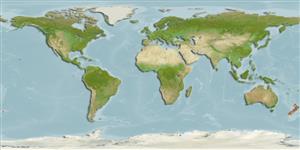Environment: milieu / climate zone / depth range / distribution range
ນິເວດວິທະຍາ
ສັດທະເລ ກ່ຽວກັບ (ຢູ່)ເທິງຊັ້ນພື້ນດິນໃນທະເລເປີດ; ລະດັບຄວາມເລິກ 0 - 20 m (Ref. 13227). Temperate
Southwest Pacific: throughout New Zealand. Records from Chatham Islands are unconfirmed (Ref. 9003).
ຂະໜາດ / ນ້ຳໜັກ / Age
Maturity: Lm ? range ? - ? cm
Max length : 6.7 cm SL ຕົວຜູ້/ບໍ່ມີເພດ; (Ref. 13227); ອາຍຸສູງສຸດທີ່ເຄຍລາຍງານມາ: 3.00 ປີ (Ref. 13227)
ຄີ (ໜາມ)ແຂງຢູ່ຫຼັງປາ (ທັງໝົດ) : 24 - 31; ຄີຫຼັງຂອງປາ (ຄີອ່ອນ) (ທັງໝົດ) : 11 - 14; ຄີ(ໜາມ) ແຂງຢູ່ຄີກົ້ນປາ
ກຸ່ມປາກະດູກແຂງ
ຄວາມຖີ່ຂອງກຸ່ມຖ່າຍທອດພັນ
ປາທີ່ມີການເຄື່ອນຍ້າຍຈາກທະເລໄປຫານ້ຳຈືດ ແລະນ້ຳຈືດຫາທະເລ
ປາທີ່ມີການເຄື່ອນຍ້າຍຈາກທະເລແລະໄປໄຂ່ຢູ່ນ້ຳຈືດ
ຄີກົ້ນຂອງປາ
ສັດທີ່ມີກະດູກສັນຫັຼງ
ການຖ່າຍທອດທາງກຳມະພັນຈາກພໍ່ແມ່ຫາລູກ: 2; ຄີກົ້ນຂອງປາ: 23 - 27; ສັດທີ່ມີກະດູກສັນຫຼັງ: 40 - 45. First dorsal fin spines V-VIII; second dorsal fin spines XIX-XXIII; third dorsal fin rays 11-14.
Discontinuous lateral line tubular scales 19-24, notched scales 14-24. Total vertebral number 43-45. Snout profile steep (70-75°). Preoperculo-mandibular canal with 7 pores, 3 at lower corner of preopercular, 3 at tip of upper jaw and 1 at lower jaw symphysis. Scale rows between anterior end of second dorsal fin and lateral line, 5-6. Scales between second and third dorsal fins, 4. Scales around caudal peduncle 12-13. Radii in scales from area below lateral line and under pectoral fin, 8-11. Long ctenii in scales from above and below lateral line in caudal peduncle area. Lateral line canal constricted with W-shaped anterior and posterior openings. Short denticles on interradial circuli. Post-temporal partially exposed. Pterygiophore supporting first segmented ray of third dorsal fin anterior to 24th vertebra. Dorsal fin formula V-0N-0-1-0-1. Ventral edge of lower caudal plate straight. Short neural spine of second preural vertebra. Epurals of different length. Soft rays in caudal fin, 14; 2 unbranched and 5 branched (non multibranched) rays in upper and lower caudal lobes. Procurrent rays in upper caudal lobe, 10; eight in lower lobe, 8; in upper lobe, 2 procurrent rays between upper lobe and posterior epural, 4 rays opposite epurals , 1 between neural spine of second preural vertebra and neural spine of third vertebra, 1 opposite neural spine of third preural vertebra and 2 anterior to neural spine of third vertebra; in lower lobe, one procurrent ray between lower lobe
and haemal spine of second preural vertebra, 5 rays opposite haemal spine of second preural vertebra, 1 between haemal spines of second and third preural vertebrae, 1 ray opposite neural spine of third preural vertebra. Rounded posterior end. Short, pointed rostrum. Broad antristrum. Excisura shallow (Ref. 84085).
Facultative air-breathing in the genus (Ref. 126274); Adults are most common in shallow water (0-5m), although recorded from depths of 30 m (Ref. 84085). They are commonly found in intertidal rock pools, particularly those with adequate rocky or algal shelter. They feed mainly on amphipods, isopods, and polychaetes (Ref. 13227). Eggs are hemispherical and covered with numerous sticky threads that anchor them in the algae on the nesting sites (Ref. 240). Larvae are planktonic which occur primarily in shallow, nearshore waters (Ref. 94114).
Life cycle and mating behavior
ການຈະເລີນເຕັມໄວ | ການສືບພັນ | ການວາງໄຂ່ | ໄຂ່ | ຄວາມດົກຂອງໄຂ່ປາ | ຕົວອ່ອນ
Fricke, R., 1994. Tripterygiid fishes of Australia, New Zealand and the southwest Pacific Ocean (Teleostei). Theses Zool. 24:1-585. (Ref. 13227)
IUCN Red List Status (Ref. 130435: Version 2024-1)
Threat to humans
Harmless
Human uses
ການປະມົງ: ທີ່ບໍ່ມີຄວາມສົນໃຈ
ເຄື່ອງມື
Special reports
Download XML
ແຫຼ່ງອີນເຕີເນັດ
Estimates based on models
Preferred temperature (Ref.
123201): 10.4 - 18.5, mean 14.9 °C (based on 161 cells).
Phylogenetic diversity index (Ref.
82804): PD
50 = 0.5039 [Uniqueness, from 0.5 = low to 2.0 = high].
Bayesian length-weight: a=0.00631 (0.00353 - 0.01129), b=3.07 (2.91 - 3.23), in cm total length, based on LWR estimates for this species & (Sub)family-body (Ref.
93245).
ຊັ້ນເຂດຮ້ອນ (Ref.
69278): 3.2 ±0.45 se; based on food items.
Generation time: 0.9 ( na - na) years. Estimated as median ln(3)/K based on 1
growth studies.
ຄວາມຢືດຢຸ່ນ (Ref.
120179): ສູງ, ປະຊາກອນຕຳ່ສຸດທີ່ໃຊ້ເວລາສອງໜ້ອຍກວ່າ 15 ເດືອນ (K=1.20; tmax=3).
Fishing Vulnerability (Ref.
59153): Low vulnerability (11 of 100).
Nutrients (Ref.
124155): Calcium = 130 [65, 298] mg/100g; Iron = 0.491 [0.264, 0.997] mg/100g; Protein = 17.2 [16.0, 18.3] %; Omega3 = 0.422 [0.172, 0.977] g/100g; Selenium = 9.31 [3.45, 25.01] μg/100g; VitaminA = 35.9 [7.7, 169.3] μg/100g; Zinc = 1.32 [0.84, 2.00] mg/100g (wet weight);
